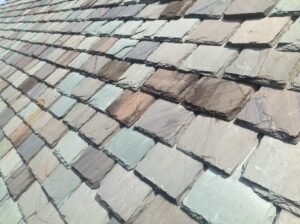Natural Slate Tile: An In-Depth Overview
Natural slate has been a preferred roofing material for centuries, renowned for its longevity, aesthetic appeal, and minimal maintenance requirements. Its enduring presence across various cultures and architectural styles underscores its significance in the construction industry.
Historical Context
The utilization of slate for roofing dates back to Roman times. In medieval Europe, structures like Conwy Castle (1283–1289) and Calder Abbey (founded in 1134) featured slate roofs, highlighting the material's durability and status. In the U.S., archaeological findings at Jamestown, Virginia, indicate the use of slate roofing even before widespread domestic quarrying began in the 19th century.
Global Sources & Quality Indicators
Slate is predominantly quarried in regions such as Spain, Wales, Quebec, Newfoundland/Labrador, and in states such as Vermont, New York, Pennsylvania, and Virginia. The quality of slate is influenced by its geological formation, with factors like mineral composition, grain structure, and absence of impurities determining its suitability for roofing. High-quality roofing slate is typically fine-grained, dense, and free from deleterious minerals that could affect its longevity.
Slate roof tiles
Color Variations and Thicknesses
Slate roofing offers a spectrum of colors, including gray, black, green, purple, and red, in unfading and semi-weathering colors as well, each imparting a distinct aesthetic to a building. These colors result from the slate's mineral content and regional origin. Thickness can vary, with some regions producing thicker slates suitable for certain architectural styles while others offer thinner options.
Structural Considerations
The substantial weight of natural slate necessitates careful structural planning. Buildings must have reinforced roofing systems capable of supporting the additional load. It's essential to consult with structural engineers to assess and, if necessary, upgrade the roof's support structure before installation.
Roofing Styles
Beyond the previously mentioned styles, natural slate roofs can be designed in various patterns, including:
Random Width and Length: Slates of varying sizes are used, creating a more rustic and natural appearance.
Diagonal Patterns: Slates are laid diagonally to the building's ridge, offering a unique visual effect.
Herringbone: A distinctive V-shaped pattern that adds texture and interest to the roof's surface.
Rolled Slate Valleys: Rolled slate valleys are often used in high-end, traditional roofing projects, particularly in areas where the aesthetic and longevity of the roof are of primary concern. They’re seen in both residential and historical building restorations.
Each style contributes differently to the roof's aesthetic and can be selected based on architectural preferences and regional traditions.
Advantages of Slate Roofing
Durability: Slate roofs can last over a century with proper maintenance, offering exceptional longevity compared to other roofing materials.
Aesthetic Appeal: The natural variations in color and texture provide a timeless and elegant look that enhances property value.
Low Maintenance: Once installed, slate roofs require minimal upkeep, primarily involving periodic inspections to address any potential issues.
Environmental Impact: Being a natural material, slate is sustainable and has a low environmental footprint throughout its lifecycle.
Considerations - While the initial investment in a slate roof is much higher than alternatives, the long-term benefits often justify the cost. It's crucial to work with experienced contractors who specialize in slate roofing to ensure proper installation and to maintain the roof's integrity over time.
Natural slate roofing combines historical significance, aesthetic versatility, and unparalleled durability. By understanding its characteristics and working with professionals, building owners can make informed decisions that align with their architectural vision and investment considerations.


